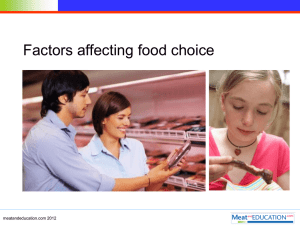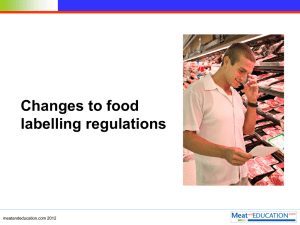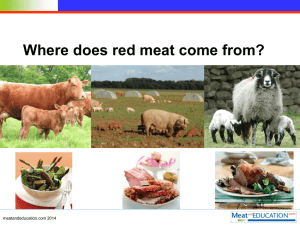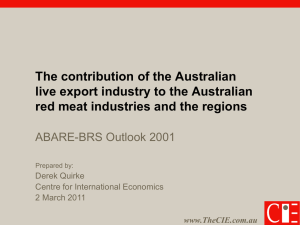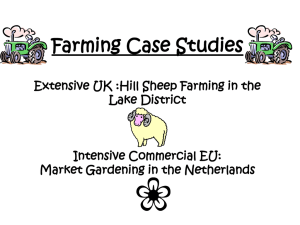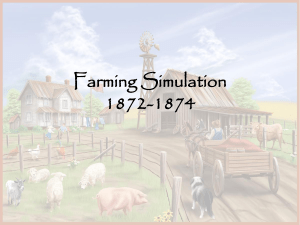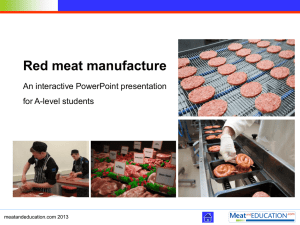Livestock farming in England and Wales
advertisement
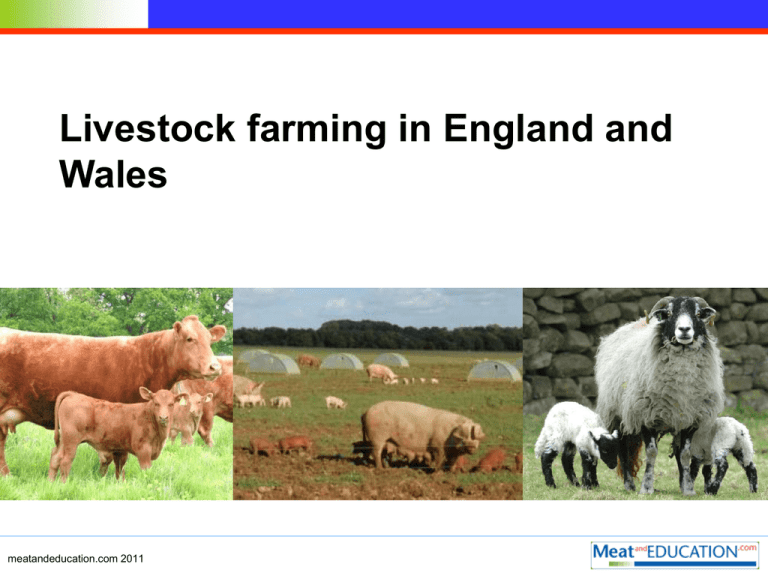
Livestock farming in England and Wales meatandeducation.com 2011 Module focus Livestock farming for meat production has been an established industry in England and Wales for many years. Over the years farming techniques have been altered and modernised. Animal health and welfare, and sustainability remain high priorities for farmers. Animals have been bred to produce leaner meat which has a positive impact on our diet and health. This module contains an overview of information on how cattle, pigs and sheep are farmed. meatandeducation.com 2011 Livestock farming in the England and Wales Cattle, pigs and sheep have been farmed for many years in the England and Wales. Cattle were originally used to help pull ploughs. Cattle were also a source of both dairy and meat products. Cattle are now bred exclusively to provide high quality milk or meat. On average, fully trimmed raw lean beef contains just 5% fat. Farmers have selected the leanest pigs for breeding. Pig meat has progressively become leaner to the extent that lean pork contains only 4% fat. Sheep originally were farmed for wool, however, wool is now considered a by-product of sheep farming with the important product being lamb. Again, better breeding and butchery techniques have led to improvements in meat quality with fully trimmed raw lean lamb having just 8% fat. meatandeducation.com 2011 Breeds of cattle British beef breeds include: • Hereford, Galloway, Beef Shorthorn, Aberdeen Angus and South Devon. Some cattle are dual purpose and are farmed for both dairy and beef production. meatandeducation.com 2011 The lifecycle of cattle In the dairy industry, a cow needs to have a calf in order to produce milk. A dairy cow will generally have one calf a year for four years before their milk production begins to decline. Only one calf is needed to replace the mother dairy cow after four years. The remaining calves are made available for sale. A cow will be inseminated, either by a bull or artificial insemination. Gestation, or the pregnancy, will last for about 9 months. Before calving, the cow enters a ‘dry period’ where the animal rests and prepares for the birth. After birth, the calf may remain with the mother or be separated, depending whether the cow is required for milk production. meatandeducation.com 2011 Finishing the cattle About half the beef in the UK comes from specialist beef cows called ‘suckler’ (because they suckle their own calves). Calves in ‘beef suckler herds’ remain with their mothers for 6 to 9 months of their life until they are separated for finishing. Finishing is where the cows and calves are fed a special diet in order to reach a weight suitable for the animals to be sent to market or abattoir. meatandeducation.com 2011 Diet of cattle Most animals spend the summer months in fields grazing and many are housed in large barns in the winter when the grass has stopped growing. Maize silage is also sometimes used as feed. The diets can be supplemented with other ingredients, for example cereals like barely or protein feeds such as beans. Cattle diets ustilise feed which humans cannot consume, for example byproducts of flour manufacture or margarine production. meatandeducation.com 2011 Breeds of pig The most popular pig breeds include: • Large White and Landrace cross females and the most popular as they are efficient at producing lean meat. • The most popular boar is the Large White. • Duroc and Hampshire are also popular breeds. meatandeducation.com 2011 The lifecycle of pigs Pigs are generally reared indoors in barns with open sides, natural ventilation and straw or slats which allow drainage of excrement. Some 40% of breeding pigs are kept outside, with huts for shade and protection from the elements. In the summer (deleted large amount) water is used to create an area for the pigs to wallow and remain cool in the heat. Pigs are like dogs and are not able to sweat to regulate their body temperature. Once a sow (female pig) has been serviced by the boar (male pig) or artificially inseminated the gestation period will last 3 months, 3 weeks and 3 days. A sow can give birth to two litters a year. meatandeducation.com 2011 The lifecycle of pigs Sows give birth in a farrowing house which contains individual farrowing crates to protect the piglets. These protect the mother and piglets during birth and while they are suckling. Outdoor Farrowing House meatandeducation.com 2011 Indoor Farrowing House The lifecycle of pigs Piglets are born with teeth and may have these clipped or ground to protect the sow’s teats and udder. This also reduces the injury of piglets when they are playing with each other. After about 4 weeks, once weaned, the piglets leave the sow to be reared in separate accommodation. Pigs are normally sent to the abattoir at 6-7 months. The farmer will decide if the sow will be taken to be served by a boar (or more commonly artificially inseminated) or to sent to the abattoir (typically after 6 litters). Adult pigs will feed on cereals such as corn and soya for carbohydrate and protein. Their diet can be supplemented with vitamins and minerals. meatandeducation.com 2011 Breeds of sheep Three main groups of sheep breeds: • Mountain and Moorland/Upland These are hardy sheep which can cope with rugged terrain, such as Welsh Mountain and Swaledale. • Longwool These are originally bred for their wool, but now used in cross breeding, such as Border Leicester and Bluefaced Leicester. • Terminal Sire Breeds These are compact muscular type of sheep suitable for grassland and less harsh environments, such as Suffolk, Charollais and Texel. meatandeducation.com 2011 The lifecycle of sheep In late summer, the sheep are prepared for mating. Feed intake is increased just before ovulation - this is called flushing. The sheep need to be in good physical and health condition. Mating, or tupping, by rams or artificial insemination occurs during the autumn. The busiest time of the year for a sheep farmer is during lambing, from January to May. A farmer will plan for lambing to take place when the weather conditions improve and the grass begins to grow. The lambs are weaned normally between 12 and 16 weeks of age. Farmers will select some females for breeding based on their physical condition and prepare the rest for sale for slaughter. meatandeducation.com 2011 Sheep farming Sheep enjoy a diet of grass. This diet can be supplemented with hay, silage and root crops, such as turnips, when grass is not readily available. Shearing takes place when the weather is warm and dry. This does not hurt the sheep. It is effectively a hair cut. Lambs do not need shearing. Sheep will be dipped in chemicals which improve the health of the animal by preventing diseases. meatandeducation.com 2011 Health and welfare of the animals Farmers spend a lot of time with the livestock monitoring their health and welfare and producing feed, such as silage. Farmers will also maintain fences, farming equipment and other areas of the farm. Veterinarians and animal nutritionists will often work with farmers to provide expert advice on improving and maintaining animal health. Each animal will also have a passport which records where the animal was born. This passport travels with it and aids traceability within the industry. meatandeducation.com 2011 Maintaining the environment Another priority for farmers is managing and maintaining the hedgerows and field boundaries, which are also wildlife habitat. Existing wetlands are preserved and managed for wildlife. Not only are trees and shrubs attractive landscape features but they are important habitats for the diversity of wildlife. Grazing cattle and sheep play an important part in managing our natural grasslands. meatandeducation.com 2011 Slaughtering Cattle, pigs and sheep are slaughtered in modern abattoirs where the conditions are strictly supervised and every effort is made to ensure that the operation is humane. This includes rendering the animal unconscious immediately prior to slaughter The animal carcase is initially divided into large ‘primal quarters’. These are then butchered into the various cuts, like roasting joints and steaks, and offal, such as liver and kidneys. meatandeducation.com 2011 Why choose the Red Tractor? The Red Tractor label is used as a mark of assurance and quality. Assurance - Individual assurance schemes not only cover animal farms and feed but also livestock transportation, the slaughtering process and the production methods for processed meats. Rigorous standards are observed throughout the supply chain. Welfare - In order to carry the Red Tractor mark, farmers must observe over 100 standards relating to animal husbandry and welfare at all stages. These range from the design of animal accommodation to staff training, health monitoring, feed, animal transportation and overall animal management. All of these are independently assessed to ensure a healthy environment for animals. meatandeducation.com 2011 Why choose the Red Tractor? Traceability - Food packing companies provide detailed records at every stage of production and allow independent inspectors access to their premises for regular checks. Every aspect of the red meat production process is fully traceable. Peace of mind - Each element (feed, farm, transport, abattoir and processing) is inspected by independent auditors at least twice a year. Red Tractor farms are inspected four times a year by specialist animal vets as well as annual spot checks by independent auditors. Farms will lose certification if they do not meet the standards. Country of Origin - The flag in the Red Tractor logo guarantees country of origin. This assures the consumer that the meat has been reared on UK farms – not just processed in the UK. meatandeducation.com 2011 Activities Complete the worksheet Farming Know How and research more information on the differences between farming cattle, pigs and sheep. Complete the worksheet Reasons to Choose the Red Tractor and investigate what other information is also found on red meat packaging. Links to Digi bites and other materials will also be made. Digi Bite Suite 2: Produce right – Food Assurance Schemes This short video clip allays consumer concerns on food safety and highlights that quality is a priority for the red meat industry with a focus on professional and acceptable welfare, animal husbandry, healthcare standards and practices. Order the following resources and use these to support student learning on this topic: Pig tales, Sheep tales, Cattle tales. meatandeducation.com 2011 Summary •Cattle, pigs and sheep have been farmed for many years in the United Kingdom. •Livestock are bred to produce lean meat which benefits consumers as part of a health balanced diet. •The different animals have different lifecycles, however the health and welfare of the animals is a priority for livestock farmers. •Livestock may graze outdoors in summer, however many animals are housed in sheds during the winter to protect them from bad weather. •Livestock housing must meet certain criteria, have good ventilation and allow the animals to move and be sociable. •Farmers also ensure that maintaining the environment is also a priority. •The Red Tractor scheme sets out strict guidelines for farming and reassures consumers about standards of production, welfare and origin. meatandeducation.com 2011 For further information and support, go to: www.meatandeducation.com meatandeducation.com 2011
